The Gothic style was introduced in England through the construction of vaults for the monastic temples built during the XII century. At the same time, the Cistercian monks contributed to introduce their own Gothic constructive methods in the monasteries they founded in Great Britain.
But along with Cistercian monks and the architects they employed, in England there were also other lay builders fully trained in the application of Gothic techniques. It is said that one of these builders intervened in the construction in 1174 or 1175 of the metropolitan cathedral of Canterbury, after the fire that on September 5, 1174 reduced to ashes most of this temple. In the detailed chronicles of monk Gervasio is told how the French master William of Sens (who had worked on the cathedral of Sens in France) was consulted and suggested to build again the part of the temple that was completely burned. William of Sens was later replaced by an English builder also named William.

The cathedral of Canterbury was completed in 1192. The apse of this large temple has an ambulatory supported by columns with monolithic shafts above which runs a triforium up to the start of the central nave’s vault. Of capital importance for the development of the then nascent English Gothic architecture was the fact that the shafts of these columns were carved in Purbeck marble coming from the insular quarries. This marble would be used in the future during the apogee of the English Gothic to build most of the country’s churches.

Other religious buildings directly derived from the cathedral of Canterbury are the cathedrals of Chichester and Lincoln, the first was damaged by a fire in 1186 and rebuilt immediately, and the second was initiated in 1192. The Rochester and Peterborough cathedrals, among others, followed the construction of Chichester and Lincoln.
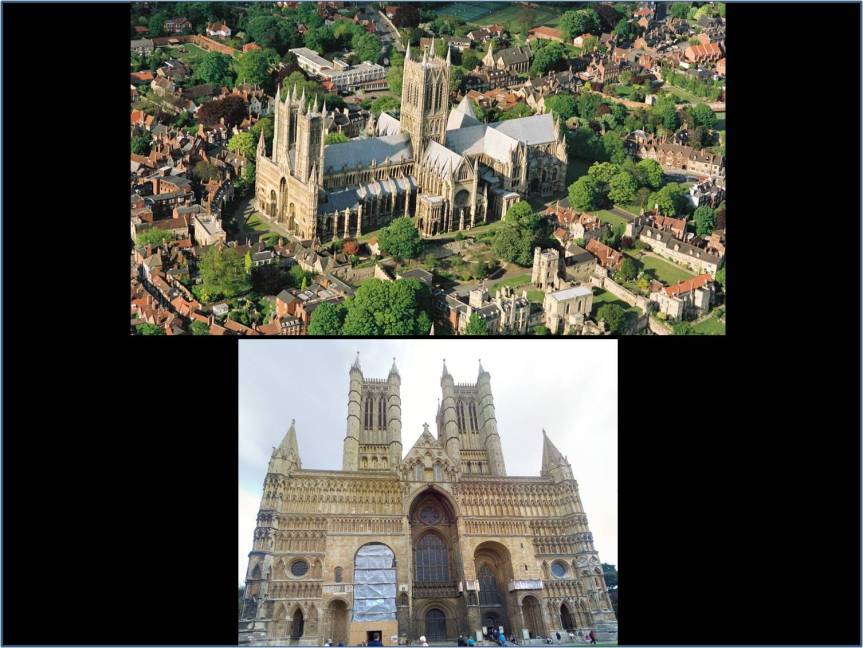
The cathedral of Lincoln is one of the English cathedrals that offer more original features thanks to the construction efforts made shortly before the middle of the XIII century. Its great façade, like an enormous rectangular cloth, is subdivided into several areas adorned with arches, the highest of which has narrow ogival arches. This façade consists of three zones that act as colossal niches: the central one, very high and finished in an ogive, includes the central Romanesque door and the great Gothic window. The lateral niches, smaller in height and topped with semicircular arches*, shelter the two side doors. This large quadrangular surface, with a continuous architectural decoration is particular because it completely lacks sculptures. The façade is limited by turrets crowned with spires and its central body is crowned by a triangular gable* and pinnacles.

However, the most interesting part of this building is located in its interior and includes the chapter room with a vestibule that connects it directly with the interior of the temple. In the vault of the chapter room a series of structural rays radiates from a large central support pillar, a feature that would constitute the precedent of a whole series of similar radial structures that will be perpetuated in the Gothic architectures of the English temples. Another merit of the Lincoln cathedral is its interior sculpture decoration, like its so-called Choir of Angels named as such because of the angelic figures carved on the arch spandrels*. The apse is square and on its exterior has a gable and pinnacles.
Two other important English cathedrals that preceded the construction of the great Westminster Abbey in the XIII century are those of Salisbury and Wells.
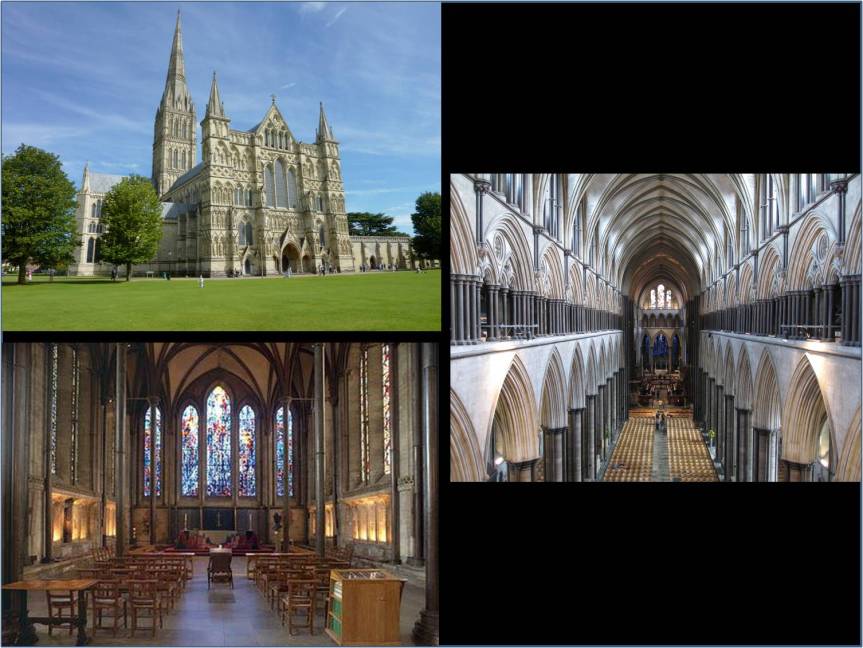
The cathedral of Salisbury was begun in 1220 and its construction lasted 40 years. This cathedral is a temple with two transepts, the first intercepts the central nave on its middle point and supports the great tower, and the second precedes the choir and apse. Like other English cathedrals, it has in the eastern end a chapel dedicated to the Virgin (Our Lady Chapel*) with a square floor plan and its three naves join the central nave.

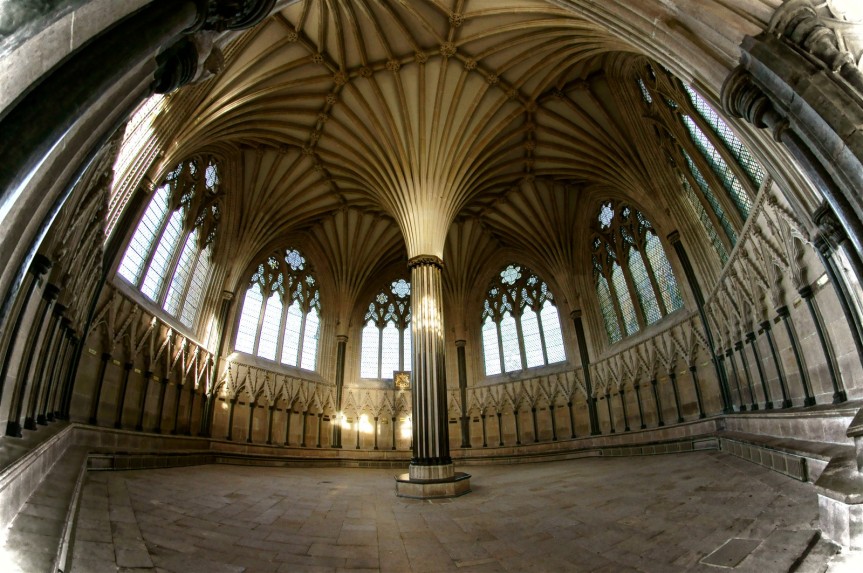
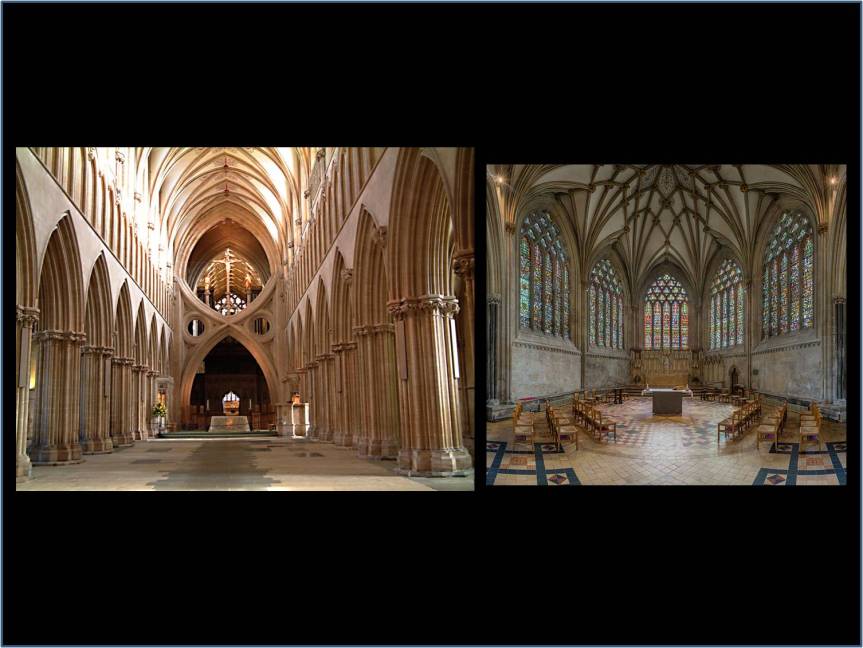
Begun at the end of the XII century following the model of the Benedictine church of Glastonbury, the Wells Cathedral in Somerset has an imposing façade with two wide and square towers at the top and a central part covered with two levels of sculptures, the higher level includes representations of the apostolate. Dozens of other sculptures are located inside Gothic niches forming vertical series on the façade. The interior of Wells Cathedral was built during the first half of the XIV century; its central nave was extended in order to join the apsidal chapel dedicated to the Virgin, and on its right the nave was connected with the chapter room located in an annex building. In this room, ribs spread radially from an elegant central pillar thus forming a vault rich in tiercerons* combined into beautiful geometric designs all over the nave’s vault. In the central point of the main nave rests a solid tower, supported by four large arches reinforced with pilasters and including curvilinear and circular lines and designs. The sculptures of the interior, mainly representing plant forms, also include some realistic burlesque heads that appear interlaced with the plant decoration. At the far end of the nave and above its union with the apsidal chapel, there is a huge window that provides natural lighting to the whole interior. Wells Cathedral is a typical example of the Decorated Style that will be discussed later.

The church of Westminster Abbey is a monument whose importance is difficult to exaggerate. In this temple all the kings of England have been crowned and hence it has become the historical center of the English monarchy. Thanks to the artistic influence of this Abbey, the particular characteristics of the English Gothic spread across the country to influence other churches that perpetuated that model.
At the site of present-day Westminster existed a small pre-Romanesque abbey church which had been planned to rebuild and expand, when in 1245 King Henry III took over the construction of the new temple which was completed in a relatively short period of time. This is a large church with three naves evidently inspired in French models to the point that it has been speculated that Henry of Reyns, its first architect, not only took as a model the structure of the cathedral of Reims, but also himself was French.

Westminster is a large temple with reinforced buttresses united to the great central nave 31 meters height by flying buttresses. Its transept is notably wider than the main nave and behind the crossing has an interior choir with the altar and tomb of St. Edward the Confessor; it also has apse with ambulatory, this last with four radial chapels (two on each side). Right in the center of this ambulatory there is the junction with the great sepulchral chapel of King Henry VII built during the first quarter of the XVI century. The southern arm of the transept forms one side of the square monastic cloister and connects on the opposite side with the chapter room.

A new modality of the English Gothic characterized by its purity of lines and the application of rich combinations of tiercerons in the vaults appeared shortly after the first quarter of the XIV century. It has been called Decorated Style* because of these characteristics.

The exterior of the buildings typical of the Decorated Style is also reflected in the windows with rich traceries placed on their upper part. The choir of Tewkesbury Abbey with its rich starry ceilings, and the vault of the old Gloucester Cathedral are both typical examples of the Decorated Style. This last cathedral shows the features that will characterize the Perpendicular Gothic* exemplified in its famous cloister decorated between 1370 and 1400 with a new style of curvilinear embellishments. This Perpendicular Style is an artistic variant that corresponds chronologically to the period of the continental Gothic architecture that has been called Flamboyant. In England, the expansion of the Perpendicular Gothic gave origin to the Tudor style* that developed during the XVI century.
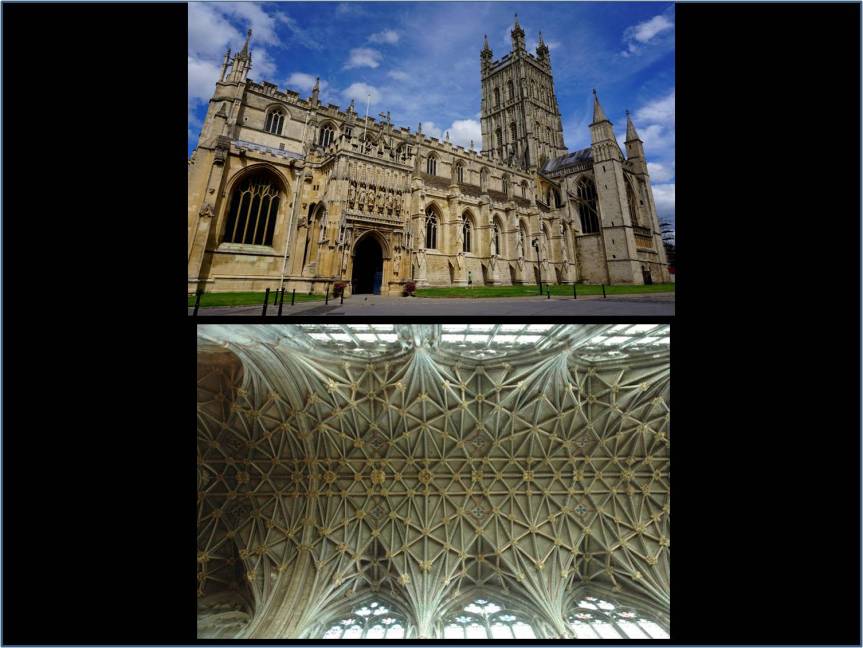
What distinguishes the Perpendicular Gothic is the multiplicity of facets (spaces) bounded by vertical lines that extend systematically along the facades. These facets are organized in series of narrow quadrangular panels whose lines are attenuated by the horizontal edgings that unify that system of repeated panels. The same happens in the windows: the mullions that divide windows are extended all the way to the top of the ogive, thus vertically subdividing the entire length of the window.
The typical vaults of the English Gothic are the “fan vaults*“, which establish a marked contrast with the rigorous verticality that dominates the exterior of the buildings. Their bound curved lines radiate from ribbed, angular or lateral “cylinders” that are usually combined with the traceries placed on the walls.



The Cloister of Gloucester Cathedral is one of the earliest examples of this type of vaults, which is also present in the vault of the choir of York Cathedral (built between 1361 and 1408) and on the ceiling of the great hall of Richard II in the old palace of Westminster (1397). But the most elegant example of a fan vault is the roof of the King’s College in Cambridge. This chapel was begun by Reginald Ely and completed by John Wastell in 1513.
The Perpendicular Style reached its highest peak in the chapel of Henry VII in Westminster Abbey. In this chapel the typical vertical lines triumph, even covering the high prismatic buttresses (with flying buttresses) topped by Gothic hoods with flower buds that merge with the walls forming facets. Also important is the rich ceiling carved in wood of this same chapel built during the first quarter of the XVI century. The same exuberance characterizes some other carved wooden ceilings like those of the old rooms of the Hampton Court palace built by Cardinal Wolsey and which date back to the reign of Henry VIII.

The Perpendicular Style is also well represented in castles such as those of Warwick and Herstmonceux.

From the last years of the Gothic period came many civil buildings of England, communal houses and, above all, those of the guilds or corporations that later would acquire immense wealth. These Guild houses had a hall or meeting room in wood, generally covered with decorated armor, and a small chapel with a fan vault. Many colleges of Oxford and Cambridge are also Gothic, with the services located around a courtyard where a decorative well was placed. To one side they have a chapel with the pantheon of the most illustrious teachers of the college; at the bottom of the courtyard there is the library, and on the other side are the buildings for the students’ rooms and the hall which serves as a dining room and a place for public ceremonies. This type of colleges or residences for students is found not only in Oxford and Cambridge: Winchester College was built at the end of the XIV century by William of Wykeham and Eton College was so by Henry VI in 1422.


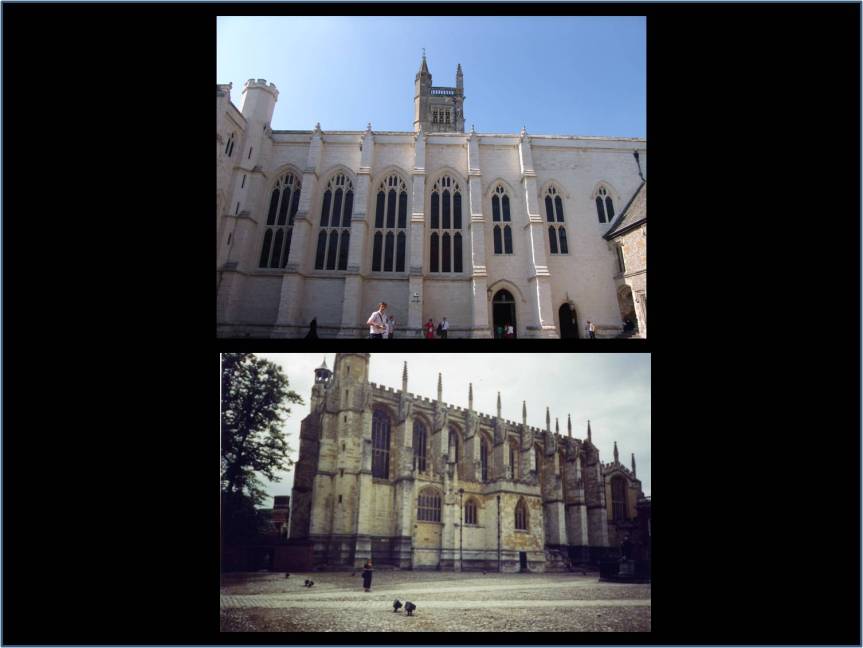
The Gothic English manor house had the hall (or “living room”) as the center of the family and social life. Other rooms were distributed throughout the building, and women had for their exclusive use the hower or dressing room. These distinctions and the distribution of services and rooms for the servitude made it necessary to extend the mansion by adding corridors side by side.

As for the English painting, the remains of mural paintings discovered in churches are scarce and from the study of their fragments can be concluded their analogy with the French miniatures of the illuminated manuscripts. The painting on board is even scarcer than the mural and few notable works have been preserved to these days. The famous Wilton Diptych, depicting Richard II accompanied by saints and worshiping the Virgin and Child (National Gallery of London) is the most famous work of the late XIV century, although it is now considered to be a work of a French painter.


Much more important is the funerary sculpture, with several tombs preserved up to these days. These recumbent statues* denote an elegant capture of the portrayed character and some are works of great artistic merit, like that of Edward the Black Prince (ca. 1380) in metal with enamel embellishments, located in the Canterbury abbey. Thanks to the export of religious themes beginning in the middle of the XIV century and throughout the XV century, we know today numerous artifacts in relief and statues carved in alabaster. These artifacts were made by the alabaster men from Nottingham and show in their works great inventiveness, artistic skill and a lively sense of composition.

England achieved great prestige in the art of Gothic embroidery, the most famous of all being those of the so-called Opus Anglicanum (as it was designated in European inventories of the time) that adorned precious capes used as raincoats and other types of luxurious garments.
_______________________________
 Semicircular arch: Also known as the Roman arch, the Semicircular Arch forms a half circle and is a major feature of all Roman architecture.
Semicircular arch: Also known as the Roman arch, the Semicircular Arch forms a half circle and is a major feature of all Roman architecture.
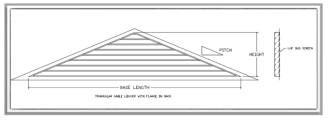 Gable: The generally triangular portion of a wall between the edges of intersecting roof pitches. A gable wall or gable end refers to the entire wall, including the gable and the wall below it. Sharp gable roofs were characteristic of the Gothic and classical Greek styles of architecture.
Gable: The generally triangular portion of a wall between the edges of intersecting roof pitches. A gable wall or gable end refers to the entire wall, including the gable and the wall below it. Sharp gable roofs were characteristic of the Gothic and classical Greek styles of architecture.
 Arch Spandrel: The space between two arches or between an arch and a rectangular enclosure. The term usually refers to the space between a curved figure and a rectangular boundary – such as the space between the curve of an arch and a rectilinear bounding molding, or the wall space bounded by adjacent arches in an arcade.
Arch Spandrel: The space between two arches or between an arch and a rectangular enclosure. The term usually refers to the space between a curved figure and a rectangular boundary – such as the space between the curve of an arch and a rectilinear bounding molding, or the wall space bounded by adjacent arches in an arcade.
 Lady Chapel: A traditional British term for a chapel dedicated to “Our Lady”, the Blessed Virgin Mary, particularly those inside a cathedral or other large church. These chapels are also known as a Mary chapel or a Marian chapel, and they were traditionally the largest side chapel of a cathedral, placed eastward from the high altar and forming a projection from the main building.
Lady Chapel: A traditional British term for a chapel dedicated to “Our Lady”, the Blessed Virgin Mary, particularly those inside a cathedral or other large church. These chapels are also known as a Mary chapel or a Marian chapel, and they were traditionally the largest side chapel of a cathedral, placed eastward from the high altar and forming a projection from the main building.
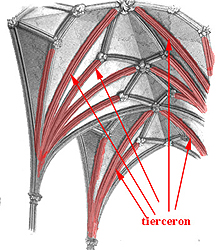 Tiercerons: A major rib in a complex rib vault. Tiercerons spring from the main springers.
Tiercerons: A major rib in a complex rib vault. Tiercerons spring from the main springers.
Decorated Style: (Also known as the Decorated Gothic) is a name given to a period of English Gothic architecture. Traditionally this period ran from 1250-1350. Decorated architecture is characterized by its window tracery. Elaborate windows are subdivided by closely spaced parallel mullions, usually up to the level at which the arched top of the window begins. The mullions then branch out and cross, intersecting to fill the top part of the window with a mesh of elaborate patterns called tracery. Vaulting became more elaborate, with the use of increasing number of ribs.
Perpendicular Gothic: A period of English Gothic architecture, characterized by an emphasis on vertical lines. The Perpendicular style began to emerge near 1350. The style developed from the Decorated style of the late 13th and early 14th centuries, and lasted into the mid-16th century. In the later examples of the Decorated Period the increased emphasis on perpendicular lines appeared as a reaction from the curvilinear forms typical of the Decorated style. The style is characterized by the perpendicular linearity in the design of windows, which became very large, sometimes of immense size, with slimmer stone mullions than in earlier periods, allowing greater scope for the elaboration of stained glass. The mullions of the windows are carried vertically up into the arch molding of the windows, and the upper portion is subdivided by additional mullions forming rectangular compartments, known as panel tracery. Buttresses and wall surfaces are likewise divided up into vertical panels. The technological development and artistic elaboration of the vault reached its pinnacle, producing intricate multipartite vaults and culminating in the fan vault.
Tudor Style: The Tudor architectural style is the final development of Medieval architecture in England, during the Tudor period (1485–1603) and even beyond, and also the tentative introduction of Renaissance architecture to England. It followed the Late Gothic Perpendicular style and was superseded by Elizabethan architecture. The four-centered arch, now known as the Tudor arch, was a defining feature. Moldings are more spread out and the foliage becomes more naturalistic.
 Fan vault: A type of vault used in the Gothic style, in which the ribs are all of the same curve and spaced equidistantly, in a manner resembling a fan. The initiation and propagation of this design element is strongly associated with England. The largest fan vault in the world can be found in the chapel of King’s College, Cambridge.
Fan vault: A type of vault used in the Gothic style, in which the ribs are all of the same curve and spaced equidistantly, in a manner resembling a fan. The initiation and propagation of this design element is strongly associated with England. The largest fan vault in the world can be found in the chapel of King’s College, Cambridge.
 Recumbent effigy: (Also called gisant (French for “recumbent”) is a recumbent statue on a tomb depicting a prominent deceased person in the process of dying or as a corpse. Such compositions, developed in western Europe in late medieval, Renaissance, and early modern times, may represent the deceased in a state of “eternal repose”, hands folded in prayer and awaiting resurrection. A husband and wife may be depicted together. An important official or leader may be shown holding his attributes of office or dressed in the formal attire of his official status or social class.
Recumbent effigy: (Also called gisant (French for “recumbent”) is a recumbent statue on a tomb depicting a prominent deceased person in the process of dying or as a corpse. Such compositions, developed in western Europe in late medieval, Renaissance, and early modern times, may represent the deceased in a state of “eternal repose”, hands folded in prayer and awaiting resurrection. A husband and wife may be depicted together. An important official or leader may be shown holding his attributes of office or dressed in the formal attire of his official status or social class.
 Lierne ribs: A minor rib in a complex rib vault. Liernes do not spring from the main springers.
Lierne ribs: A minor rib in a complex rib vault. Liernes do not spring from the main springers.
